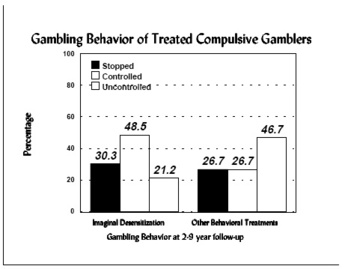During the 1980s, Australian researchers* developed a treatment technique called imaginal desensitization (ID). The ID model was based on the idea that systematic desensitization would allow individuals to control their impulsive behaviors. The patient describes four situations in which he or she typically gambles or thinks about gambling. These situations are then modified so that, in theory, the patient does not feel a need to gamble and leaves the situation in a relaxed state. The ID treatment begins with the therapist leading the patient through a five-minute series of relaxation techniques while resting on a comfortable couch in a darkened room. The relaxation techniques include asking the patient to alternately tense and relax muscle groups in their bodies. After the patient is relaxed, the therapist guides the patient through the gambling situations, moving from the situation with minimal anxiety to situations with greater anxiety. The therapist moves on when the patient indicates that the situation has been successfully visualized while maintaining a relaxed state. Five-day treatment protocols included two 15-20 minute sessions on the first day and three 15-20 minute sessions on the subsequent days. The study compared the outcomes of 120 pathological gamblers who were randomized to imaginal desensitization or to alternative behavioral therapies (electric aversion therapy, imaginal relaxation, exposure therapy, or prolonged exposure therapy). Sixty-three of the 85 patients contacted 2-9 years after they had been treated agreed to be interviewed. These respondents identified whether they currently did not gamble, gambled in a controlled manner, or gambled in an uncontrolled manner. Controlled gambling was defined as gambling up to $10 a week for pleasure without financial hardship, and a desire to continue to gamble at this level. A contact for each respondent also was questioned to corroborate the patient’s self-report. Of those who were treated with ID, 78.8% stopped gambling or became controlled gamblers compared with 53.4% of those treated with alternative behavioral methods.
Source: *McConaghy, N. (1988). Assessment and management of pathological gambling. British Journal of Hospital Medicine, 40, 131-134.
This public education project is funded, in part, by The Andrews Foundation.





